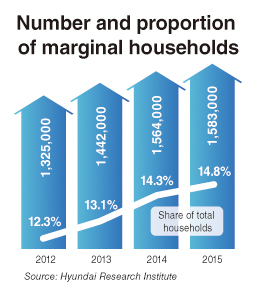Korea second among emerging markets in household debt growth
By Korea HeraldPublished : March 21, 2016 - 14:28
Korea saw the second fastest increase in household debt among emerging economies in 2015, a new study shows.
The study, released by the Institute of International Finance, put Korea only behind China in the expansion of household debt relative to gross domestic product.
The study, released by the Institute of International Finance, put Korea only behind China in the expansion of household debt relative to gross domestic product.

Korea marked a 3.45 percentage point increase in its household debt-to-GDP ratio, ranking second after China out of 19 developing countries. China’s debt ratio gained 3.49 percentage points.
By per capital debt, Korea ranked third after Singapore and Hong Kong. The country’s per capita household debt was $29,000, compared to $42,000 of Singapore.
The high household leverage is a nagging concern for Korea which has been trying to spark the slowing economy with stimulus and record-low interest rates. Household debt surpassed 1,200 trillion won ($1.03 trillion) for the first time at the end of last year, according to the Bank of Korea.
 The IIF report also revealed that the aggregate household debt of 19 emerging economies was nearly twice the level seen before the 2008 global financial crisis. The total amount surpassed $8 trillion, rising by $335 billion from a year ago. That is tantamount to 35 percent of the countries’ combined GDP.
The IIF report also revealed that the aggregate household debt of 19 emerging economies was nearly twice the level seen before the 2008 global financial crisis. The total amount surpassed $8 trillion, rising by $335 billion from a year ago. That is tantamount to 35 percent of the countries’ combined GDP. Across the emerging world, the household sector is logging debt growth that is faster than the growth of the economy itself, the IIF pointed out. It cited ample market liquidity, owing to the monetary policy measures taken to spur the economy, as a key reason.
In the meantime, the Hyundai Research Institute said in a report that more and more Korean households had difficulties paying off their debt with their income last year.
The institute said “marginal households” whose debt-to-disposable income ratio is over 40 percent tallied at 1.58 million, accounting for 14.8 percent of the total. The figure was up from the 12.3 percent in 2012.
By Lee Sun-young (milaya@heraldcorp.com)
-
Articles by Korea Herald








![[Hello India] Hyundai Motor vows to boost 'clean mobility' in India](http://res.heraldm.com/phpwas/restmb_idxmake.php?idx=644&simg=/content/image/2024/04/25/20240425050672_0.jpg&u=)










